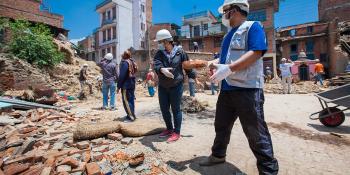
Rebuilding after disaster
Pathway to Permanence: Rebuilding Homes and Hope After Humanitarian Disasters
Habitat for Humanity has worldwide experience responding to natural and man-made disasters from hurricanes in the southern USA to the 2004 Indian Ocean tsunami and the earthquakes which hit the Caribbean nation of Haiti and Chile in South America in 2010.
Habitat works with local communities, governments and other organizations, but the focus is always on providing permanent housing solutions for people vulnerable to, or afflicted by natural disasters, conflicts and other calamities.
Rebuilding homes and lives after a disaster may take many years. But Habitat starts from the Day After.
Habitat moves quickly to provide:
- Early response: Clean up, home repairs and transitional shelter
To clear the way for home repairs and new construction, Habitat for Humanity mobilizes local volunteer groups and provides them with tools – such as shovels, wheelbarrows and crowbars – to remove debris and salvage materials that can be recycled for new shelter.Clean up activities may involve cash-for-work components to provide families with support and stimulate the local economy. Clean up work also contributes to a survivor’s mental strength and emotional healing. It’s an active opportunity for displaced residents to directly help with recovery.
Habitat emergency shelter kits help families make immediate repairs and construct temporary shelters.
Where appropriate, Habitat and local families work to build transitional shelters – durable homes with sanitary facilities which meet basic international humanitarian needs and which can withstand the elements. These shelters later can become the basis of permanent homes or dismantled and the parts used for new homes elsewhere.
- Long-term response: Reconstruction
As soon as conditions on the ground realistically allow, Habitat for Humanity begins rebuilding damaged homes and new permanent housing. A popular approach is to build a core house; a small, well-constructed, disaster resilient structure that can be extended and expanded as a family’s circumstances and finances allow. Habitat has successfully used the core house model after the 2004 Indian Ocean tsunami, and following an earthquake in Indonesia in 2009.
Habitat offers other post-disaster experience to provide:
- Technical and organizational expertise – Habitat works with aid agencies, government planners and other groups, including UN bodies, to provide expertise in shelter construction.
- Risk reduction – Habitat and its partners offer training on how to protect property and communities from the risk of further destruction through preparedness and mitigation programs.
Disaster-affected families who have lost their livelihoods are not in a position to repay mortgage loans. However, they are encouraged to contribute “sweat equity” in rebuilding their homes and communities.
To extend its reach Habitat for Humanity establishes Habitat Resources Centers in key locations often with partner groups. Centers provide expertise in one or more of such areas as project and construction management; appropriate technology including the production of low-cost, high-quality building materials; and providing construction skills training and employment opportunities for local people.
Rebuilding After Disasters in the Asia-Pacific Region
Habitat has responded to many disasters in the Asia-Pacific region. Its largest was an ongoing program to help victims of the 2004 Indian Ocean tsunami. By the time the program was completed in 2010, an estimated 25,000 families in India, Indonesia, Sri Lanka and Thailand should have benefited from Habitat reconstruction programs.
Habitat offices have responded to a range of recent disasters including:
2011
Earthquake/tsunami: Japan, Earthquake: New Zealand
2010
Cyclone Tomas: Fiji
2009
Bushfires: Australia
Earthquakes: West Java and West Sumatra, Indonesia
Tsunami: Samoa
Typhoon Ketsana: Philippines, Vietnam, Cambodia
Flooding: Bihar and Andhra Pradesh, India
2008
Earthquake: Sichuan, southwestern China
Cyclone Nargis: southern Myanmar.
2007
Cyclone and flooding: Bangladesh
Tsunami: Solomon Islands
Severe flooding: Jakarta, Indonesia
Landslides and typhoons: the Philippines.
2006
Earthquake: Yogyakarta, Indonesia,
2005
Earthquake: mountainous parts of Pakistan
Outside the Asia-Pacific region, Habitat has been involved in rebuilding homes after the 2010 earthquakes in Chile and Haiti, and following Hurricanes Katrina and Rita which hit the southern USA in 2005, as well disasters that hit in Romania and Lebanon and elsewhere.